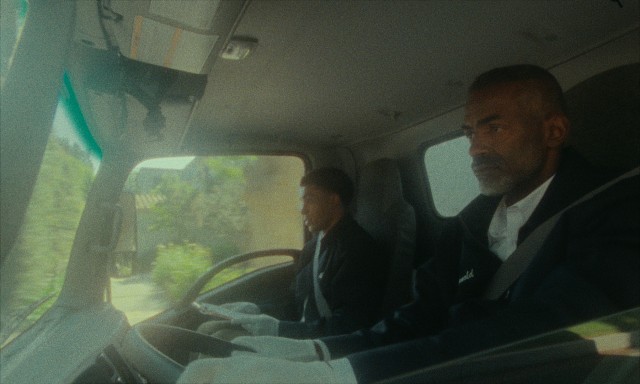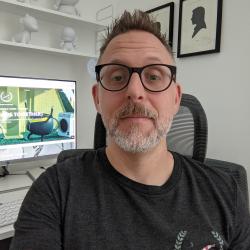Chester Vincent Toye’s 11-minute short Hangtime is a film that is hard to define. An enigmatic tale of a pair of fine art handlers and their latest delivery, over its short duration the story walks a fine line between the surreal and the humorous, leaving viewers with plenty to digest.
“I made Hangtime to explore a version of the art world that I’ve never seen on the screen”, Toye reveals as we discuss how his short was inspired by his own experiences assisting conceptual artist Hank Willis Thomas and the Kerry James Marshall painting Still-Life with Wedding Portrait (which depicts a Black wedding portrait being installed by a pair of gloved black hands).
Following in the footsteps of these renowned artists, the writer/director aimed to explore “the beautifully rich and complex range of conflicting and co-existing Black experiences” on screen, by creating a story that wasn’t focused on the Black artist, but instead captured the unseen world of the Black art worker, aspiring artist, and collector in one narrative.

David McClain Jr (L) and DeMorge Brown as the pair of fine art handlers delivering a controversial sculpture in Hangtime
We first meet the film’s fine art handlers around 30-seconds into the short, as a close-up of our young aspiring artist (David McClain Jr.) slowly zooms out to reveal DeMorge Brown (I Was There Too) in the driving seat. This patient 90-second shot, with very little dialogue, is an intriguing primer of what’s to come, as Toye challenged himself to return to his roots as a large format photographer and slow his process down.
This results in the film being presented in a series of 10 long shots (if you include the opening shot before the title card) with little camera movement and minimal lines exchanged between actors. Toye chose to shot his film this way as he wanted to allow his crew time to focus on the set-up of each scene and place his viewers in a “more objective, distant, and voyeuristic perspective”.
This deliberate, slower pacing also forces the film’s audience to experience events, and the discomfort that comes with them, in real-time, but those long takes wouldn’t work if it wasn’t for the outstanding performances of Hangtime’s central trio McClain Jr, Brown and Latarsha Rose. With the short’s director praising their “trust and immense talent” for making his vision a success, explaining that without that the “tone would’ve fallen flat” and they could have ended up wasting “tons of film”.
“Shooting on 16mm encouraged a slower and more considered shooting process during production”
The decision to shoot on 16mm was one made to “separate the world of the film from our reality and ease viewers into the strange and twisted world” that Toye creates in Hangtime. The director credits the short’s distinct look on his collaboration with cinematographer Pierce Marcel Robinson, explaining that working with him installed “a lot of confidence on set”, his input essential in creating the beautiful overall look of the film and giving each of the 10 shots a distinct feel.
Shooting on 16mm also forced the director and his team to stick to the “slower and more considered shooting process” they set out to achieve in pre-production. The resulting effect, of blending this original narrative with such a patient production, makes for as truly distinct and original short. There’s no huge drama and no standout moments, but the overall impact of the short really sticks with you and the talent of Toye is undeniable.
That talent is now being focused on the director’s debut feature film and we’re eager to see if this deliberately gentle approach continues in the longer format.

 Rob Munday
Rob Munday